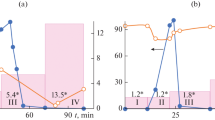Abstract—
Technologies for recycling effluent waters from pretreatment, reverse-osmosis plant concentrate, and demineralized water from a polishing plant that have been approbated under field conditions are proposed. It is shown that the application of these technologies is efficient in solving resource-saving problems. For the topping ultrafiltration plant, the use of the considered technical solution makes it possible to return 82–88% of the effluent water volume to the permeate. Reverse-osmosis plant concentrate is suggested to be forwarded to an H-cation exchange filter charged with a weak-acid cation exchange resin. The filter is incorporated into a closed loop for multiple use of regeneration solutions that contains a crystallizer in which calcium sulfate is extracted from a supersaturated regeneration solution. The permeate from the H-cation exchange filter is divided into two flows. One of these flows is mixed with the ultrafiltration plant permeate, and the other is removed from the demineralization plant process circuit and is used as makeup water for cooling systems or water supply and heat-supply systems or is removed into the environment. For estimating the efficiency of the proposed technical solutions, specially developed mathematical models of individual processes were used. It is shown that it is possible by applying the proposed scheme for recycling the effluent water from a membrane demineralization plant to achieve 91.8–99.0% efficiency of using natural water relating to the hydrocarbonate class and sulfate group, which encompasses the overwhelming majority of surface fresh water sources. By applying the regeneration solution multiple usage loop for recycling the reverse-osmosis plant concentrate, it is possible to return a significant part of the concentrate into the main cycle and to extract commercial-grade calcium sulfate from the concentrate. It was also shown from the accomplished calculations that the application of the proposed concentrate recycling technology is inexpedient for source water belonging to the hydrocarbonate class and magnesium group. The schemes for recycling effluent water according to the proposed technology can be practically implemented by using standard equipment and technical solutions approbated under field conditions.

Similar content being viewed by others
REFERENCES
Water Strategy of the Russian Federation for the Period until 2020, Approved by RF Government Decree No. 1235-r of August 27, 2009.
V. I. Danilov-Danil’yan, Global Water Resources and the Prospects of the Russian Water Management Complex (Tipografiya LEVKO, Moscow, 2009) [in Russian].
A. A. Panteleev, V. F. Ochkov, and S. S. Gavrilenko, “Schematic and technological solutions in water treatment plants on the basis of integrated membrane technology for combined-cycle steam–gas thermal power plants,” Energosberezhenie Vodopodgot., No. 4 (90), 11–16 (2014).
B. M. Larin, A. N. Korotkov, M. Yu. Oparin, and A. B. Larin, “Experience gained from putting new technologies of water treatment in use at thermal power stations,” Therm. Eng. 57, 646–652 (2010).
Methodology for Calculating Water Balances of Water Bodies, Approved by Order of the Ministry of Natural Resources of the Russian Federation RF No. 314 of November 30, 2007.
E. B. Yurchevskii and V. V. Solodyannikov, “Waste water membrane desalination plants and their utilization. Ultrafiltration,” Energosberezhenie Vodopodgot., No. 2 (106), 3–13 (2017).
E. B. Yurchevskii and V. V. Solodyannikov, “Computational–experimental verification of technologies of utilization of the concentrate formed in the reverse-osmosis water demineralization cycle,” Therm. Eng. 65, 487–492 (2018). https://doi.org/10.1134/S0040601518070091
E. B. Yurchevskii, V. V. Solodyannikov, M. A. Pichugina, and Yu. V. Solodyannikova, “Development and verification of a program for calculating the quality of the filtrate of reverse osmosis plants, intended for use in mathematical models of water treatment plants, including reverse osmosis desalination,” Energosberezhenie Vodopodgot., No. 2 (118), 3–8 (2019).
E. B. Yurchevskii and V. V. Solodyannikov, “Description of mathematical model of water demineralization process with application of membrane technologies and the concentrate disposal unit,” Energosberezhenie Vodopodgot., No. 1 (123), 55–62 (2020).
Yu. Yu. Lur’e, Handbook of Analytical Chemistry (Khimiya, Moscow, 1989) [in Russian].
O. A. Alekin, Fundamentals of Hydrochemistry (Gidrometeoizdat, Leningrad, 1953) [in Russian].
Author information
Authors and Affiliations
Corresponding authors
Additional information
Translated by V. Filatov
Rights and permissions
About this article
Cite this article
Yurchevskii, E.B., Solodyannikov, V.V. Resource-Saving Solutions for Membrane-Demineralization Plants. Therm. Eng. 68, 577–583 (2021). https://doi.org/10.1134/S0040601521050128
Received:
Revised:
Accepted:
Published:
Issue Date:
DOI: https://doi.org/10.1134/S0040601521050128




